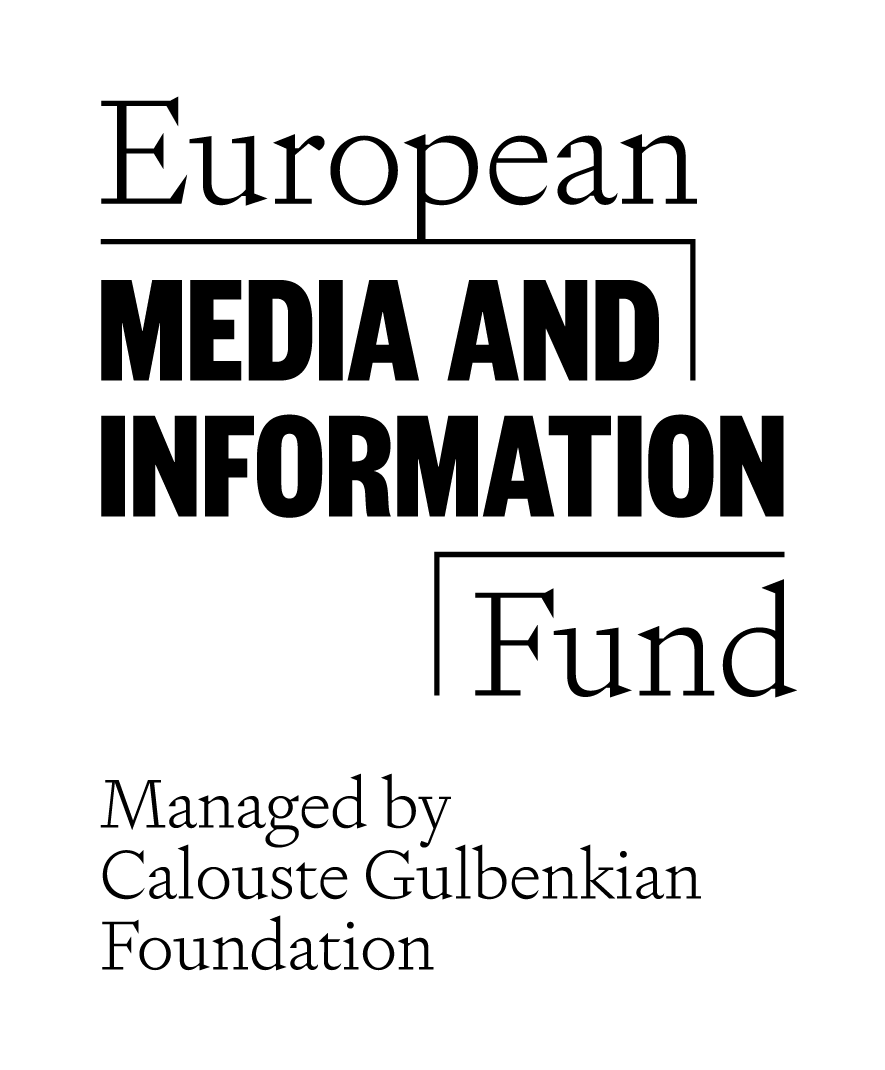Smeared, discredited and threatened by the far-right next door
Report and investigation by Christian Jakob, Jean-Philipp Baeck and Luisa Kuhn
Sept. 28, 2023
Alexander Roth is a young journalist, deputy editor of the online edition of Waiblinger Zeitung, a regional newspaper in the federal state of Baden-Württemberg. The region is a stronghold of Germany’s anti-vaxx-groups and conspiracy-ideologists of the so-called Reichsbürger scene. Roth has been reporting on their activities since the start of the pandemic and since then has been continually attacked on- and offline.
Back to Decoding Disinformation homepage >>
Political background
“Querdenken“ (anti-vaxx)-groups
Approximately three months into the onset of the pandemic, protests emerged in Berlin in opposition to the government’s COVID-19 measures and quickly spread across Germany. Right from the outset, these demonstrations served as a gathering point for diverse political factions, encompassing esotericists, members of alternative communities, former Green and Left voters, as well as right-wing and predominantly conspiracy-oriented individuals. The far-right political party AfD swiftly attempted to position itself as a leading force within these protests.
In August 2020, various groups, initially identified as “Querdenker” (translated as “lateral thinkers” or “contrarians”), managed to mobilize tens of thousands of people for a rally in Berlin. The event was titled the “Day of Freedom,” a phrase that bore a striking resemblance to Nazi propaganda director Leni Riefenstahl’s film about the 1935 Nazi Party Congress. On this particular day, protesters ascended the steps leading to the Reichstag, the home of the German parliament. However, their attempts to breach the interior of the building ultimately proved unsuccessful.
The forms of action later became highly heterogeneous, ranging from weekly marches and rallies demanding an end to lockdowns or mandatory masks to attacks on busy high-speed train lines, such as the incident near Schweinfurt in early January 2021. Some protesters gathered in front of hospitals and threatened to enter intensive care units in an attempt to challenge the government’s claims of a “lying” propaganda regarding the absence of COVID-19 patients. They also demonstrated in front of the private homes of high-ranking politicians, like CDU Prime Minister of Saxony Michael Kretschmer in January 2021, and some even appeared carrying flaming torches. A group from Neustadt an der Weinstraße planned a so-called “Operation Klabautermann,” aiming to cause nationwide blackouts, overthrow the government, and abduct leading Social Democrat health politician Karl Lauterbach, who is now the federal minister of health. In Idar-Oberstein, a man shot and killed a young gas station attendant who had asked him to wear a mask as required.
Between 2020 and 2022, this milieu both stabilized and radicalized, often described as a “cross-front” where former leftists found common cause with the extreme right, primarily driven by shared conspiracy ideologies. Even after the pandemic waned, some of the same actors continued protesting on other issues, such as the energy transition or the Ukraine war.
Anti-vaxx groups in the state of Baden-Württemberg
Activists from Baden-Württemberg assumed a prominent role in orchestrating nationwide large-scale demonstrations. Notably, the local group known as “Querdenken 711,” led by Michael Ballweg, quickly became emblematic of the broader movement referred to as “Querdenker.” In May 2020, Ballweg successfully rallied approximately 5,000 demonstrators at Stuttgart’s Cannstatter Wasen square.
Several factors underpin Baden-Württemberg’s emergence as a stronghold for the Corona protests. State representative Michael Blume, tasked with combating anti-Semitism, has drawn parallels between the Corona protests and historical Swabian resistance against Prussian authorities. Furthermore, there are notable overlaps between the “Querdenker” movement and esoteric-religious movements, particularly anthroposophy. The ideology espoused by Rudolf Steiner, who had previously criticized vaccinations, has found fertile ground in Baden-Württemberg. The region boasts historical significance as the birthplace of the first Waldorf school in 1919, and it houses the headquarters of the Anthroposophical Society in Germany.
Moreover, the influence of Pietism is palpable in the Stuttgart vicinity. This conservative, Bible-believing strain within Protestantism is often affiliated with the Evangelical Revivalist movement and continues to exert influence within the Protestant church in Baden-Württemberg today.
Basel-based sociologists Nadine Frei and Oliver Nachtwey presented a study of the local Corona protests for the green party’s Heinrich Böll Foundation at the end of 2021. They interviewed 1,152 people who had taken part in demonstrations. According to Nachtwey and Frei, the “Querdenken” movement in Baden-Württemberg is mainly fed by the milieus of vaccination opponents, homeopathy supporters and esotericists. The participants are “characterized by a deep alienation from the core institutions of liberal democracy.” Parties, science and the media are distrusted and they are not interested in criticizing individual Corona measures: “In the Corona protest movement, criticism functions as an intrinsic value,” the sociologists said.
The composition of the “Querdenker” movement in Baden-Württemberg differs significantly from that in East Germany, where a higher presence of right-wing extremists and aggressive hooligans is observed during demonstrations. Nevertheless, even in West Germany, Querdenker individuals have established connections with right-wing extremists. Founder Michael Ballweg, for instance, maintains ties with prominent Reichsbürger figure Peter Fitzek. Within this group of individuals who reject the Federal Republic of Germany and often advocate for a return to a German Reich, the State Office for the Protection of the Constitution in Baden-Württemberg identifies approximately 3,800 individuals, including 380 who are willing to resort to violence. This number is notably higher than the average in other regions of Germany.
Nationwide, authorities estimate the presence of approximately 21,000 individuals associated with the Reichsbürger and self-governing movements. According to the Office for the Protection of the Constitution, the newly designated category for Corona protesters, “Delegitimization of the State Relevant to the Protection of the Constitution,” includes approximately 350 supporters in Baden-Württemberg.
Propensity to violence
Since the onset of the Corona pandemic and the protests against Covid measures, Germany has witnessed a disturbing trend of recurring attacks on journalists. In 2022, Germany slid to the 21st position in the annual press freedom ranking by Reporters Without Borders (RSF), marking a significant drop of 10 places compared to early 2020. In 2022, RSF documented over 100 physical assaults on journalists, marking the highest level since the organisation started keeping records. A significant majority of these attacks occurred within the context of conspiracy ideologies, anti-Semitism, and extreme right-wing affiliations.
An initiative known as “Between the Lines” (BTL) has emerged to provide protection services for freelance journalists covering demonstrations. Their primary focus is on safeguarding journalists during events associated with conspiracy ideologies and extreme right-wing movements, particularly in the federal state of Saxony.
Johanna Scholz, a representative of BTL states that in many cases, the demo participants would not be classified as belonging to the far-right spectrum at first glance. Presumably, many would describe themselves as belonging to the political center. “Throughout the protests against the Corona measures, these individuals have undergone a process of radicalization, evolving into staunch opponents of the measures they initially protested against and the challenges they encountered.” This perceived state of resistance is often cited to justify attacks, including those targeting members of the press, under the notion that “in the face of injustice, resistance becomes imperative”, Scholz explains.
In the absence of other targets – there were rarely counter-demonstrations during the Corona pandemic – attacks on the press have become increasingly common within these protests. Journalists, and at times even the police, have often found themselves as the sole outsiders amidst such demonstrations. According to Scholz, “People feel justified in their actions because they perceive the press as untrustworthy, disseminating false information.” Consequently, they view attacks on journalists as justifiable. Klemens Köhler, Scholz’s colleague, elaborates, “Demonstration participants perceive press representatives as part of a more influential entity with a specific agenda, such as discrediting the protests.”
The attacks on Alexander Roth
Online attacks
On New Year’s Eve 2020, various groups within the conspiracy-ideological spectrum called for demonstrations in Stuttgart. In mid-December 2020, the German government imposed a strict lockdown due to rising Corona infection figures, and on New Year’s Eve, a nationwide assembly ban was in effect. Despite these restrictions, several hundred Querdenker supporters gathered in downtown Stuttgart. One of the speakers was Heinrich Fiechtner, a former member of the AfD and a non-factional member of the Baden-Württemberg state parliament.
Roth reported on this demonstration, including Fiechtner’s appearance. Prior to publishing the article, Alexander Roth shared certain passages with Fiechtner, providing him with an opportunity to comment. Fiechtner then published Roth’s inquiry and his own responses on his Telegram channel, where he referred to Roth as a “Schornazist,” a term he coined for journalists he considers disagreeable, likening them to Nazis. Fiechtner’s actions triggered a wave of hate messages, with Roth’s author photo and email address shared in a Telegram post. In the comments section, Roth was referred to as a “greaseball” (“Schmierlappen”). One user went further, stating ominously, “Nothing will happen without bullets in the head. The movement needs a lone perpetrator to take a swing at every government politician.”
Telegram was not the sole platform used to target Roth. Zeitungsverlag Waiblingen (ZVW), Roth’s newspaper, shared his article on the New Year’s Eve demo on Facebook. A user commented, “[…] I will make this Roth disappear, a puppet of the Broadcasting Council and the German State Broadcaster, where it is dictated what is right and true.” This marked the second indirect death threat Roth received within days as a result of his article.
Throughout 2021, two local Querdenker individuals, Heiko M. and Markus H., specifically targeted Roth. They maintained Telegram channels through which they regularly incited against him – See section “Social Network Analysis by CeMAS”. In April 2021, Heiko M. threatened Alexander Roth with a video invoking the idea of a new edition of the Nuremberg trials, triggered by Roth’s research into Heiko M. and his connections to the far-right Reichsbürger scene. In July 2021, Heiko M. and Markus H. appeared at Roth’s workplace, the ZVW building, and later posted a video of the encounter on Telegram. They claimed they wanted to invite Alexander Roth for a beer, falsely asserting that Roth wanted to join them but was not allowed to due to differences in opinion, accusing him of “kissing the publisher’s ass.” A few weeks later, M. and H. returned to the premises under false pretenses, stating at the reception desk that they wanted to have coffee with Roth, even though this invitation had never been extended.
Towards the end of 2021, Roth reported on Twitter about the consequences of continuous threats from the “Querdenker” scene for his work. Michael S., a local far-right activist, posted a screenshot of Roth’s tweet on his Telegram channel, mockingly remarking, “Uuuh, the little Alexander is scared.” This sparked a barrage of derogatory labels for Roth, such as “far-right hack” and “man-despising radical racist.” Michael S.’s post gained significant traction on Telegram.
In January 2022, the “Querdenker” movement mobilized against a public event where Alexander Roth spoke about right-wing extremism in the region. A Telegram call urged attendees to “participate” in the event. Notably, far-right video blogger Nikolai Nerling, known as “der Volkslehrer” and a Holocaust denier, shared the call on his Telegram channel, falsely asserting that Roth was Jewish, which led to a surge in anti-Semitic comments directed at Roth.
Attacks at demonstrations
In addition to online hostilities and their aftermath, Roth has faced repeated personal attacks while covering rallies as a reporter, even when physical violence was not involved. It’s important to note that the region Roth reports from sometimes witnesses more than 30 anti-vaxx rallies in a single day, with only a few journalists covering these events. Roth quickly became known and, consequently, a target for both speakers and participants in these demonstrations.
For instance, on April 3, 2021, Roth was reporting on a demonstration in Stuttgart alongside freelance journalist David Peters, who was punched in the face by an aggressive, seemingly intoxicated man from the protest march. The attacker then verbally abused Peters.
Right-wing activist Michael S. photographed or filmed Roth during demonstrations, posting the pictures on Telegram. Following one such post, a Telegram user remarked, “At least now you know what this creature looks like.” Roth later commented on this, stating, “Because so many people now know what I look like, covering demonstrations is always fraught with difficulties for me. I am recognized, slandered, insulted, and intimidated. I am not allowed to perform my job freely.”
During a demonstration on October 5, 2022, Roth noted that he was being stared at, photographed, and filmed. One woman commented amusedly, “His hand is shaking,” which seemed to amuse onlookers. Michael S. and Markus H., activists, posted about Roth during this demonstration, with S. referring to Roth as having “honorary membership in Antifa terror groups.” Passers-by repeatedly expressed their displeasure, such as by showing middle fingers to Roth. According to H., he informed the “Querdenker” speaker Ralph B. during the demonstration that Roth was present, prompting B. to address Roth from the stage, greet him as a representative of the “Waiblinger Blatt,” and ask where he was, even encouraging Roth to take notes and pose for photos to the amusement of the crowd.
At the same demonstration, Alberto A. delivered a speech – see chapter on main actors – in which he expressed his pleasure that the “left-wing press” was present. He claimed the press had previously labeled the protesters as right-wing extremists and “Schwurbler” (a pejorative term for Corona measures critics). A. asserted that the people gathered there were honorable and only sought to defend their rights, criticizing the attempt to categorize them as ridiculous. He directed these remarks at Roth, who was standing at the edge of the rally. A. then asked the demonstrators to raise their hands if they considered themselves “right-wing extremists,” but no one did. A. then pointed to Roth saying, “Mr. Roth, look how many right-wing extremists there are here. Look before you spread these lies in your paper again. Where is there a right-wing extremist here? Show him to me.” One demonstrator, referring to Roth, said: “He’s on your right.” A. continued, “Here, there he stands,” and in Roth’s direction, he said: “Mr. Roth, have respect for these people. Stop agitating.” The demonstrators began chanting “Lügenpresse, Lügenpresse” (“lying press”), a phrase popularized at far-right Pegida marches in Dresden back in 2014. Roth was filmed, photographed, verbally targeted from the stage, shouted at, and denigrated, leading him to remark that it sometimes felt as if the demonstration was directed against him.
Filed complaints with the police
Roth became aware of the comment on the Facebook post “I’m going to make this Roth disappear” much later, when a colleague brought it to his attention towards the end of 2021. The colleague reported the incident to the local police, and the case was referred to the Hamburg public prosecutor’s office since the defendant resided there. The defendant’s name and address were eventually discovered during the investigation. However, in July 2021, the public prosecutor’s office dropped the case, citing insufficient suspicion for the reported offense of disturbing the public peace. Alternatively, they could have investigated the offense of insult, but for that, Roth would have needed to file a criminal complaint himself. In Germany, insult is considered an application offense, meaning it is only prosecuted when the aggrieved person files a complaint within three months. Roth was unaware that this option was available, and the public prosecutor’s office failed to inform him.
In the case of Michael S., who referred to Roth as a “right-wing extremist Reichsbürger writer” on his Telegram channel, Roth forwarded screenshots to the relevant criminal police department the day after the message appeared. Several months later, the police sent Roth a criminal complaint form for libel, which he filled out and returned. The public prosecutor’s office then initiated an investigation into Michael S. for insult. In November 2022, the proceedings against Michael S. were discontinued because the required criminal complaint had not been filed within the three-month period.
Josephine Ballon, a lawyer and Head of Legal at HateAid, an organization that assists victims of digital hate crimes, notes that hate crimes on the Internet often take the form of insult offenses. “It’s just not up to the victims to identify which offense is involved in their cases. Those affected sometimes do not even realise that the criminal offense is one of insult, but assume that it is a threat, which is, however, subject to very high legal hurdles.” Ballon also points out that in many insult cases, victims are unaware that they must file a criminal complaint within three months and do so in paper form, “that’s where it would be helpful if police and public prosecutors themselves would point this out or refer to counseling structures that support those affected with legal issues”.
In November 2022, Roth filed a complaint against Heinrich Fiechtner, who made an insulting post on Telegram, including a screenshot of Roth’s author page with a photo, describing him as “smug, mendacious, inflammatory, characterless, wallowing deep in the Nazi and Stalin swamp.” Fiechtner continued to agitate against Roth, sharing Roth’s denunciation with the words, “Alexander Roth, one of the most miserable whiners of the Schorrnazistenszene […]. His fragile hateful interior quivers so much that the mimimi has now even activated the police (SOKO Fiechtner, exists since 2019) […].”
Protection measures
The ongoing attacks on Alexander Roth pose a constant threat to his safety. As a local journalist, he is at risk of being recognized on the street by individuals he reports on, some of whom may harbor ill intentions. Roth maintains regular communication with the police regarding his safety and undergoes security assessments before any public appearances. On Twitter, Roth wrote: “I don’t take a step without asking myself how safe I am. When I approach my home, I turn around every few seconds. When I’m out privately, I have all the demo dates in the back of my mind – so I don’t accidentally walk into one.” Even this message was used on Telegram channels to further incite violence against Roth.
When covering demonstrations, Alexander Roth must be prepared for potential attacks. Within the editorial office, discussions frequently revolve around which assignments he can safely undertake. This consideration extends beyond demonstrations and includes events where he is invited as an expert.
During a summer event in 2023, which we attended with him, a security assessment was conducted in consultation with the police. On this occasion, Roth opted to use a company car rather than his private vehicle to minimize the risk of a personal attack.
In 2022, when Roth received a local journalism award, the ceremony had to be held under high-security measures, including keeping the location confidential and providing police protection with bomb-sniffing dogs. While the event proceeded without incident, the persistent sense of threat remained. Furthermore, determining the necessary security precautions for such occasions is a time-consuming process. Roth revealed that he spent a week on security planning for the award ceremony, time that could otherwise have been dedicated to research.
In the area where he resides, Roth is cautious about disclosing his profession to avoid inadvertently causing tensions with local residents. He also takes great care to safeguard the details of his personal life. As he explains, “This is a challenge I face as a local journalist – I report on people who are very closely connected to my community, and they may encounter me on the street or at social gatherings.”
The most important actors behind the attacks on Roth
Heinrich Fiechtner
Heinrich Fiechtner, an oncologist who runs his own practice in Stuttgart and is a former member of the AfD in the state parliament, gained notoriety as a prominent figure in the anti-vaxx movement in Baden-Württemberg. He also played a significant role in the attacks against Alexander Roth. In November 2022, he posted on his Telegram channel, describing Roth as “most smug, mendacious, inflammatory, wallowing deepest in the Nazi and Stalin swamp,” accusing him of affiliations with extreme ideologies, and urging his followers to remember him. Fiechtner made these remarks on the eve of an event that Roth was planning to cover. A Telegram user commented ominously, “Alexander, I have good news for you: You won’t have to be afraid much longer….” Fiechtner allowed this comment to remain in his channel without response.
During another event in Stuttgart where Fiechtner spoke, Roth was present as a reporter. Fiechtner read aloud one of Roth’s tweets to the audience, suggesting that Roth could impress him if he could manage to write a factual contribution for once.” Roth had previously posted a tweet announcing that the far-right was “demonstrating once again” on that day. To mock on him, Fiechtner raised his right arm, resembling a Hitler salute, prompting jeers from the crowd.
On his Telegram channel, Fiechtner further criticized Roth by likening him to a “red-green-brown Streicheradept,” implying that he followed the ideology of Julius Streicher, the editor of the Nazi propaganda paper Der Stürmer. Fiechtner accused Roth of endangering children’s lives by spreading disinformation about the state’s Covid vaccine recommendations. He wrote: “Because of your disinformation, children may die. Do You care? You know what they call people like that who bring harm and death to others? I despise people who arrogantly tread on human lives in their own self-importance.”
Elsewhere on Telegram, Fiechtner referred to Roth as a “washcloth-in-chief” and “one of the most shameless liars in the ‘good’ Streicher tradition,” who complained about being intimidated and thus unable to do his job. Fiechtner sarcastically dismissed Roth’s grievances.
In a video posted on a Telegram channel shows a talk with Fiechtner. Written on that post, it can be read how Roth was referred to as “Nazi Alex” and “the so-called vaccination toth (‘dead’), who receives special awards for indoctrination and propaganda from journo-fascists.”
When asked for a comment, Fiechtner invited us to his office on the morning of June 15, 2023. During our two-hour conversation, he expressed his grievances about media coverage of the pandemic and Corona protests. Fiechtner specifically criticized the reporting of the Waiblinger Zeitung and Alexander Roth, labeling Roth as a “hard-headed ideologue” and emblematic of the “modern journalist” who conflates opinion with factual reporting and applies labels based on ideological trends. Fiechtner argued that Roth’s description of the Corona protests as “right-wing” and monitored by the Office for the Protection of the Constitution (German domestic intelligence, VS) was intended to manipulate public sentiment. He asserted that it was essential to note that the VS operates under the instructions of interior ministers, suggesting that its actions are influenced by the fact that the Greens govern in Baden-Württemberg.
Alfredo A.
Alfredo A., who operates a small food import business in a suburb of Stuttgart, is another notable figure involved in the hostilities against Alexander Roth. A. has been an activist in the Corona protests since 2020 and has organized numerous rallies, including one in 2022 where he featured documentaries at a “film vigil” in Stuttgart’s Schlossplatz. These documentaries included appearances by individuals such as Dr. Sucharit Bhakdi and conspiracy influencer Heiko Schöning, who made unsubstantiated claims about the Corona pandemic. A. also showcased a “gallery of horror” at a rally, displaying photos of alleged “vaccination victims.” Counter-demonstrators at A.’s rallies were sometimes told that they had “poison in their masks.”
Roth, who had previously covered these rallies, observed one such demonstration on October 5, 2022. During the event, A. delivered a speech and expressed satisfaction that the “left-wing press,” which had initially labeled their group as “right-wing extremists, Schwurbler (anti-vaxxers), Querdenker (contrarians), and Alu-Hat-Wearers,” had attended. He noted that on that day, people of “high moral character” had gathered to “defend their rights.” A demonstrator pointed toward Roth, who was standing at the edge of the demonstration, and A. said, “Mr. Roth, show respect for these people. Stop agitating.” The demonstrators began chanting “Lügenpresse, Lügenpresse” (lying press), an exclamation popularized at far-right Pegida marches in Dresden since 2014. Roth later tweeted about the event, stating that he had been filmed, photographed, labeled as an enemy from the stage, shouted at, and denigrated, adding that it had felt like a demonstration against him at times.
On June 14, 2023, we approached A. before the start of a rally he had organized in downtown Stuttgart and asked him to comment on Roth. A. argued that demonstrators had a right to criticize without being subjected to tendentious insults, as he claimed Roth had done. He emphasized that the press should not support them, but it also should not insult them by using the term “Schwurbler,” a critical term for members of anti-vaxx groups. However, Roth had only used the term “Schwurbler” once, quoting it in reference to a dating platform for the anti-vaxx community. A. stated that he rejected the term “Querdenker” and preferred “Selbstdenker” (self-thinker). Nonetheless, the movement, particularly in Stuttgart, had adopted the term “Querdenker” as its own identifier since 2020. A.accused Roth of stigmatizing the term. He viewed the way the press had portrayed Corona demonstrators as an “affront to human dignity,” comparing it to actions one might expect in a dictatorship rather than a democracy. A. expressed suspicion that the media was behaving this way because “it was influenced by financial interests, potentially seeking subsidies, investments, or sponsorship from the state or other sources, including the pharmaceutical industry.” This, according to him, was the only way to explain the degradation in reporting standards.
We accompanied the demonstration through downtown Stuttgart to the state headquarters of the Green Party, where A. called for a reevaluation of the perceived injustices related to Corona. During the event, A. played the song “AfD” by right-wing rapper Kaia Boehm over the loudspeakers, referring to it as an “election commercial” for the party, despite the AfD distancing itself from it. The song includes strongly worded criticisms of Green ministers, describing them as “ugly cunts who supposedly govern this country but betray it every day anew,” and expressing disdain for the government. Despite the clearly right-wing extremist lyrics, no one at the rally took offense.
Michael S.
Michael S. primarily targets Alexander Roth with online attacks on Telegram. Besides Heinrich Fiechtner’s channels, the “Antifa & Aufklärung von Remstal Rebell” channel is particularly active in disseminating messages about Roth, boasting over 2,200 subscribers (see chapter on Network Analysis by CeMAS). The channel is connected to Michael S., who lives in a regional town near Stuttgart and is associated with the far-right scene. He first gained political attention a few years ago by stoking xenophobic sentiments during the refugee crisis.
In 2016 and 2017, he organized right-wing demonstrations, as an expression that his hometown „defends itself“, promising “education about security and refugees.” During the same period, he briefly tried to run for mayor, objecting to being labeled right-wing by a local newspaper despite his claims of political neutrality.
Subsequently, S. has kept an eye on the Antifa scene at the periphery of demonstrations and has faced physical attacks himself. In the fall of 2021, S. faced trial for insulting journalist Alfred Denzinger, the editor-in-chief of the left-leaning regional online news portal Beobachter News. Denzinger also accused S. of disclosing his private addresses, which led to multiple paint attacks on his home and car. S. denies this accusation and any responsibility for it.
In a personal conversation in June 2023, we met S. at a café on the outskirts of his hometown, where he clarified that he had only published Denzinger’s known business addresses, not his private one.
During our conversation, S. shared insights into his radicalization journey. It all began in 2014 when a friend recommended Alex Jones, a U.S. host known worldwide for his right-wing views. Before that, S. considered himself mainstream and uninterested in such topics. S. described a classic path to radicalization that experts have long warned about: platforms like YouTube are designed to present increasingly extreme content to maintain user engagement. In the realm of political content, this often leads to a shift toward right-wing extremism.
During our meeting, S. emphasized that he only wanted to ask questions, for example, about the prehistory of the Ukraine war or the German invasion of Poland. Without being asked, he lectured on the entire range of right-wing talking points, relativized the human influence on climate change, spoke of increasing knife attacks, of at least indirectly controlled migration to Germany, and mentioned some theories about people from Africa having their own psychology and culture.
According to S., Alexander Roth is a denunciator and a provocative figure for many.
However, he downplayed the connections between the “Querdenker” movement and right-wing extremism, as highlighted by Roth’s reporting. S. suggested that Roth labels people as right-wing extremists merely because they organized right-wing rock concerts years ago, without considering their current beliefs. He also questioned the intentions of individuals carrying black-white-red flags (symbols of the pre-democratic German Reich), wondering whether they were genuinely extremist or merely expressing anger, and if so, what “Reich” they were referencing. S. would not understand why protesters should distance themselves from far-right extremists such as Holocaust denier Nikolai Nerling, known as the “People’s Teacher” for his videos, when they participate in demonstrations.
When confronted with the idea that his own posts about Roth might incite violence, S. initially denied responsibility, but later let it slip that he knew this was a gray area.
Network-Analysis by CEMAS
In order to understand the background of the attacks more precisely, we asked the experts from the Center for Monitoring, Analysis and Strategy (CeMAS) to support us with an automated network analysis. CeMAS has years of interdisciplinary expertise on the topics of conspiracy ideologies, disinformation, anti-semitism and right-wing extremism.
CeMAS: The attacks on Roth emanated primarily from Telegram
The relevance of the Telegram platform in the German-speaking region began to rise as early as 2018. During this time, the far-right “Identitarian Movement” had lost its influential profiles on Instagram and Facebook, as Facebook categorized them as a “hate organization” and implemented a deplatforming strategy as a moderation measure. Consequently, the Identitarian Movement decided to focus its online activities on Telegram. This platform was known for its minimal content moderation and created the myth that it never responded to government inquiries, although this myth did not hold up in reality.
The organization of local groups was intended to provide the Identitarian Movement with a new way of decentralized information distribution. Even if Telegram were to delete high-profile channels, the information network would remain intact and could quickly establish new channels. This idea of local and decentralized networks on Telegram was adopted in April 2020 by the largest Facebook group at the time, “Corona-Rebels,” with about 60,000 members. During this period, many of the Telegram channels and groups that still exist today within the conspiracy ideology milieu were established.
Telegram offers capabilities beyond those of a simple messaging service (e.g., Signal or Threema). Public channels and so-called “Supergroups” enable communication with hundreds of thousands of users. Channels are primarily focused on one-way communication: channel subscribers receive all the information published by the channel operator and can only interact with it to a limited extent (e.g., through comments or emoji reactions). The channel operator can not only publish their own messages on the channel but can also share messages from other channels (or groups) in their own channel – these forwarded messages always include the option to visit and potentially subscribe to the original channel.
Telegram is more of a social network than a mere messaging service, with a focus on groups and channels and extensive participation options such as surveys, comments, voice and video chats. Unlike other social networks, Telegram does not offer a personalized “feed” determined by algorithms – the platform’s interface is purely chronological, prioritizing channels that have most recently posted messages.
This is why the function of forwarding messages from other channels on Telegram is particularly important: the more frequently messages are forwarded through channels with a large number of subscribers (and hence, a wider reach), the more users see these messages. This increases the likelihood that these users will also subscribe to the original channel.
Shared Messages – Shared Ideology
Through these message forwards, various conclusions can be drawn. Channels are more likely to share messages that align with their positions and beliefs, as they aim to provide this information to their own subscribers. With each shared message, channels also (passively) promote the channels they share: this often leads to new subscribers for those channels. If channels frequently reference each other, it can be assumed that they address a similar audience.
This method of information dissemination allows for the creation of a network that uses shared messages as a basis to identify different subgroups within the overall network. This network is based on 2,816 channels and 1,892 groups identified by CeMAS as German-language conspiracy ideology or far-right channels. Approximately 400 channels and groups were compiled for this purpose in March 2020 by experts and organizations in the fields of antisemitism research, far-right extremism research, and disinformation awareness. Each channel and group was individually assessed to determine if it primarily disseminated German-language content and could be characterized as primarily conspiracy ideology, far-right, or antisemitic.
Posts about Alexander Roth on Telegram
Discussion of Alexander Roth’s work began in local groups in July 2020. In these discussions, the journalist was accused of inciting against the demonstrations and, in particular, targeting Stephan Bergmann, the former spokesperson for Querdenken711 with connections to the Reichsbürger milieu.
“Hello Mr. Roth, in today’s issue of the Waiblinger Zeitung, you are inciting against the participants of the freedom demonstration in Berlin again. And you are publicly accusing Stephan Bergmann. Were you personally in Berlin, or are you just parroting? Do you personally know Mr. Bergmann or anyone from the chat? Stand up and show your face. A face-to-face discussion, do you dare?”
— JürgenS., 16.07.2020
Messages like these were written in the local and public group “Different and Forward Thinking from RMK – Waiblingen, Winnenden, Fellbach, Backnang, Schorndorf, Welzheim #Freedom #Peace.” In total, there are 266 messages directly related to Alexander Roth. For this, all messages from the CeMAS dataset were searched for terms that could be associated with Alexander Roth, such as his name, his Twitter profile, or the nicknames given to him by the scene, like “Schorrnalist.”

The number of messages is distributed across all pandemic years. Alexander Roth is repeatedly identified as an enemy, with particular emphasis on former state legislator Heinrich Fiechtner, who consistently discusses the journalist through two channels. The channel “Antifa & Enlightenment by Remstal Rebels” also publishes a significant number of messages about Roth.
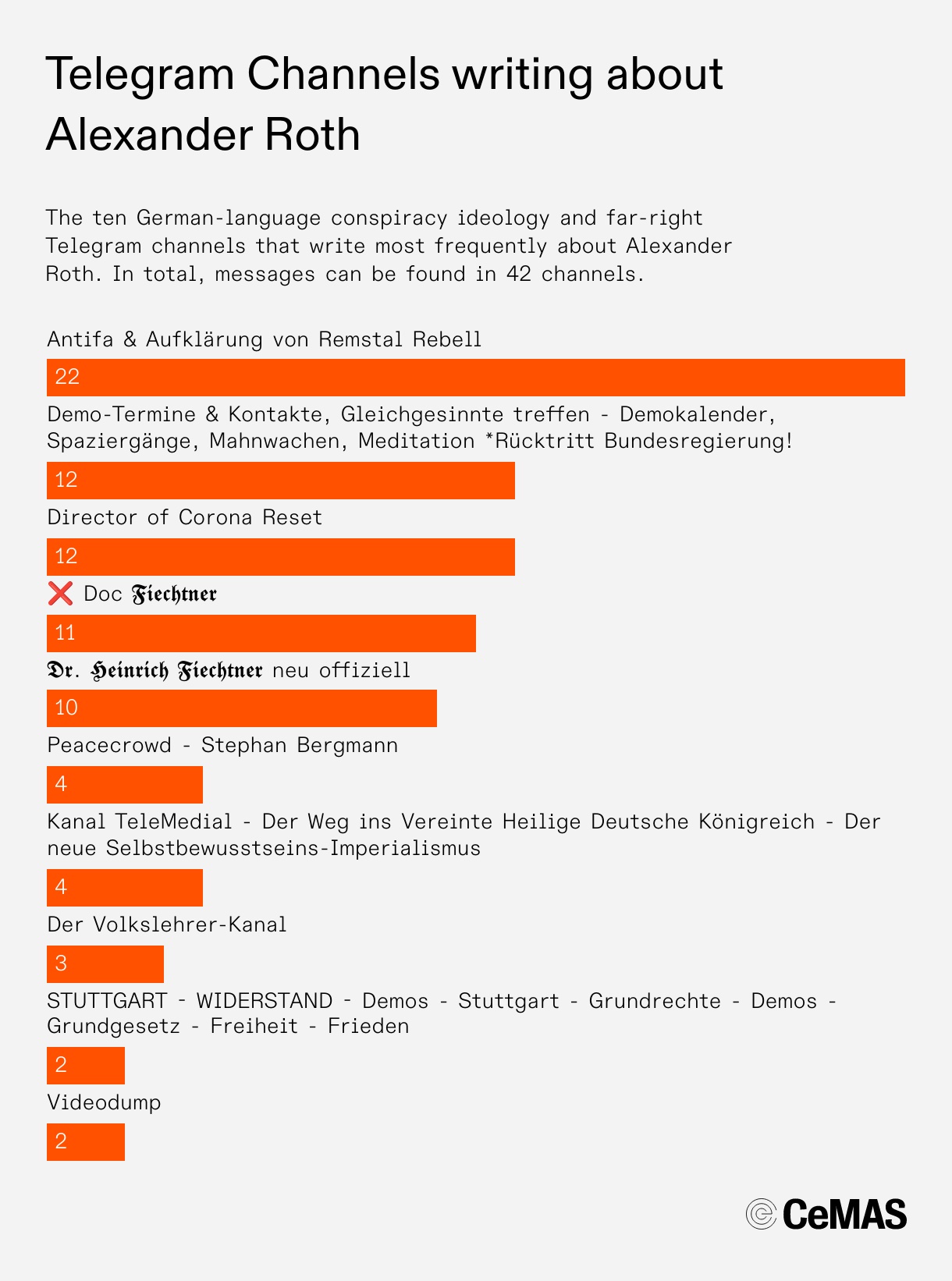
The attacks are often defamatory and, for example, mock the sense of insecurity expressed by Roth in a public tweet. The threat is concrete in nature. For instance, publications like the following were accompanied by comments such as “Nothing will happen without bullets in the head” and “The movement needs a lone perpetrator.”

In this publication by “Antifa & Enlightenment by Remstal Rebels,” contact information for Roth was provided, and they mocked Roth’s tweet about his personal threat situation. The post clearly aims to contact Roth’s employer. The reporting by Roth is relativized to historical events, equating it with the Nazi era. This post was not only published on “Antifa & Enlightenment by Remstal Rebels” but also on “Demo Dates & Contacts.” Further defamation can be found, for example, in Heinrich Fiechtner’s posts.
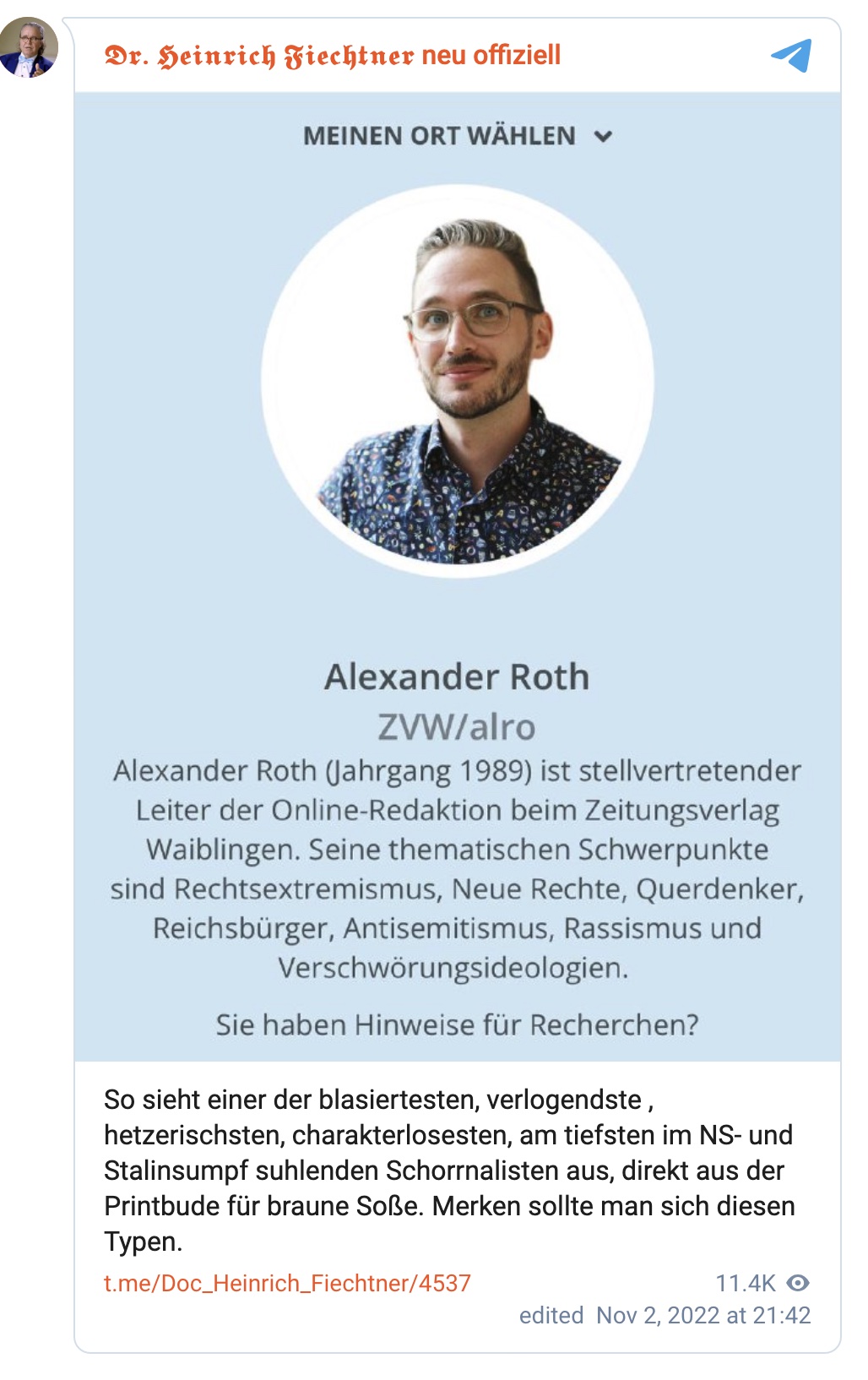
With the words “One should remember these guys,” reference is also made to a “Day X” – a day of reckoning – where names should be collected. The handling of these lists ranges from lawsuits to fantasies of destruction.
The Hate Network
Regarding the channels that frequently discussed Roth, a strong regional focus is evident. Most of these channels focus on the Waiblingen area, making the threat from local actors greater. They may have knowledge of Roth’s whereabouts.
When considering how often these channels share content with each other, it’s also notable that almost all channels (with few exceptions) shared news about Roth with each other and were interconnected. The connection between two channels suggests that a message from one channel was shared by the other. To identify particularly relevant actors, various network prominence measures were used. In this case, channels with particularly high Eigenvector Centrality are highlighted with larger font sizes:
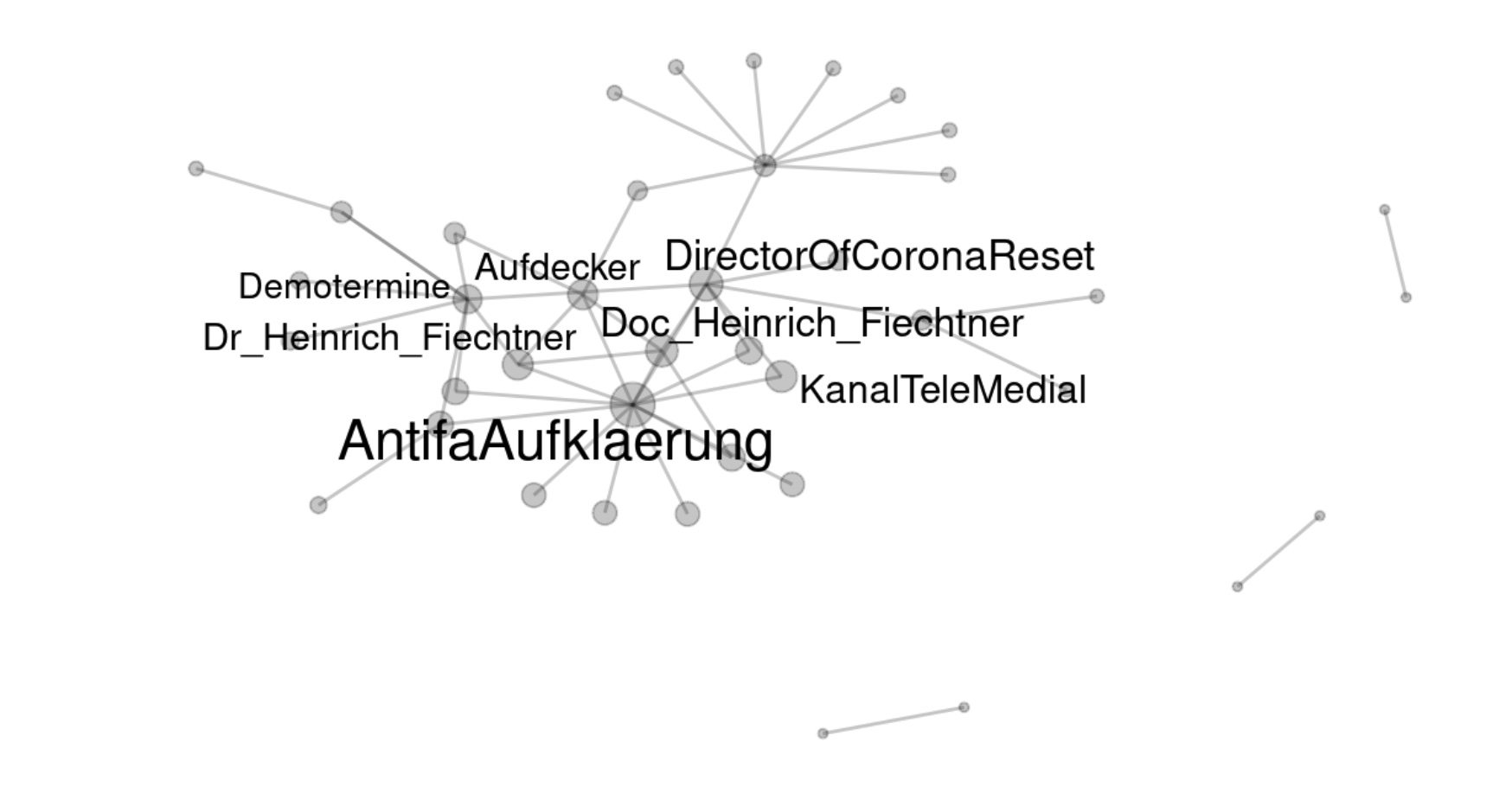
Eigenvector Centrality evaluates not only the number of connections to identify particularly relevant actors but also whether the nodes they are connected to are frequently referenced. Thus, spamming or a particularly close connection between only two actors is weighted lower than a channel that is more frequently referenced by many other channels.For better visualization, only the usernames on Telegram were used, not the complete channel titles. Channels with an Eigenvector value above 0.3 are highlighted.
The network graphic shows that the channel “Antifa & Enlightenment by Remstal Rebels” (abbreviated here as the username AntifaAufklaerung) plays the most prominent role in the network that repeatedly discusses Alexander Roth on Telegram. Heinrich Fiechtner is represented by two channels, both of which are particularly influential. The reason for his presence with two channels is not known, but both channels are still active.
The actors with the highest influence will be further examined in the context of the entire network of the conspiracy ideology and far-right scene in the next step, in order to draw conclusions about their audience.
The Hate Network and Its Audience
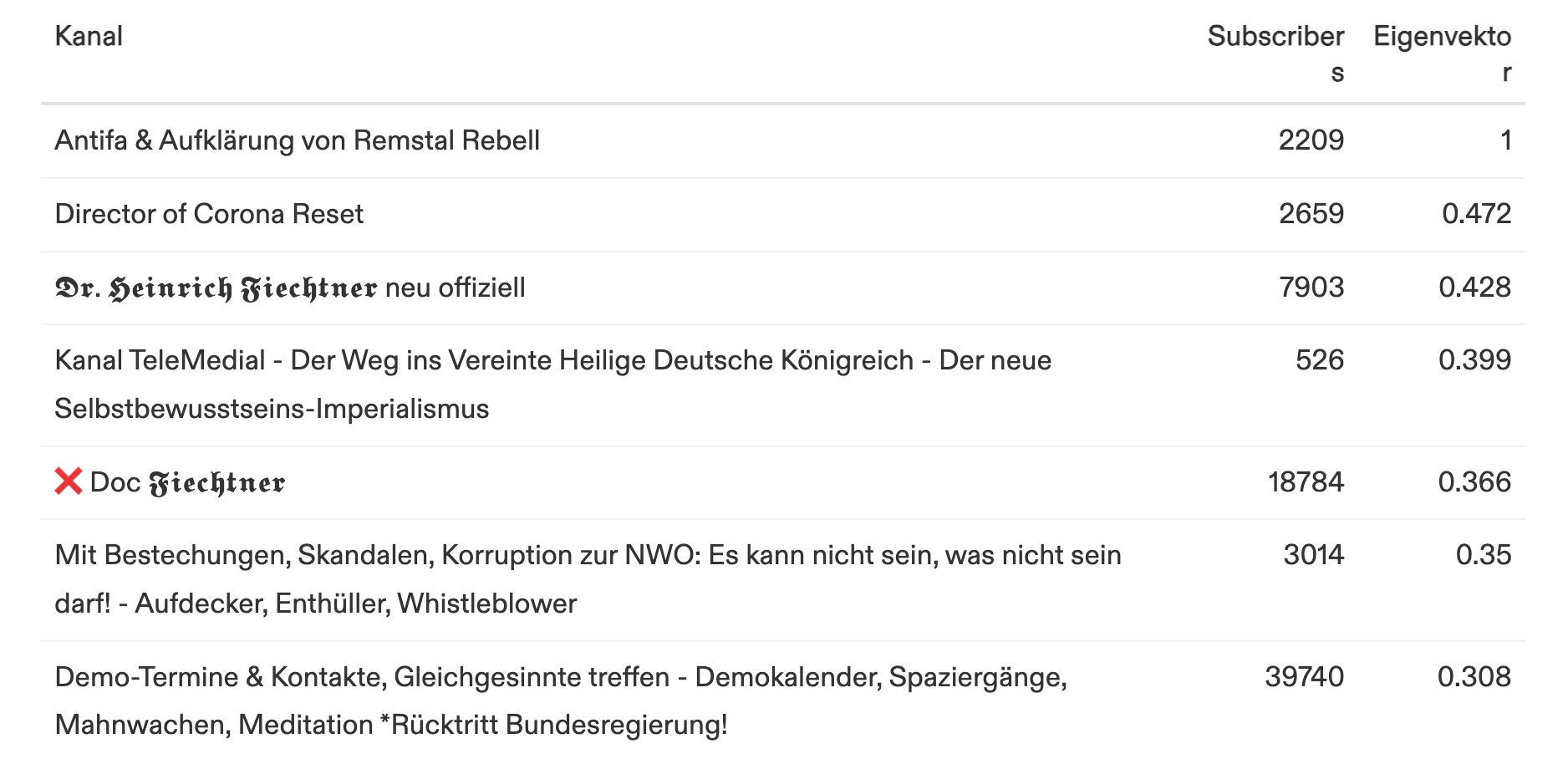
Through the 2,816 channels included in the entire CeMAS dataset, a network can be created based on the messages shared there. As mentioned at the beginning, ideologically similar channels are also located in close proximity within the network. Eigenvalue centrality is used as a particular measure of prominence here – channel titles in larger font sizes have higher Eigenvector values, and the size of the nodes indicates how many subscribers the channel has.
To visualize the network, Gephi was used with the ForceAtlas2 layout algorithm. ForceAtlas2 can particularly weight the connections between network nodes: if one channel frequently cites another channel, they are shown closer together in the visualization. This results in a network that allows conclusions to be drawn based on spatial proximity and position within the overall network. Channels that are centrally located in the network are cited by many other channels in the overall network. Channels at the periphery, on the other hand, are rarely cited by other channels – islands emerge when channels frequently connect with each other but are scarcely linked to the rest of the network.
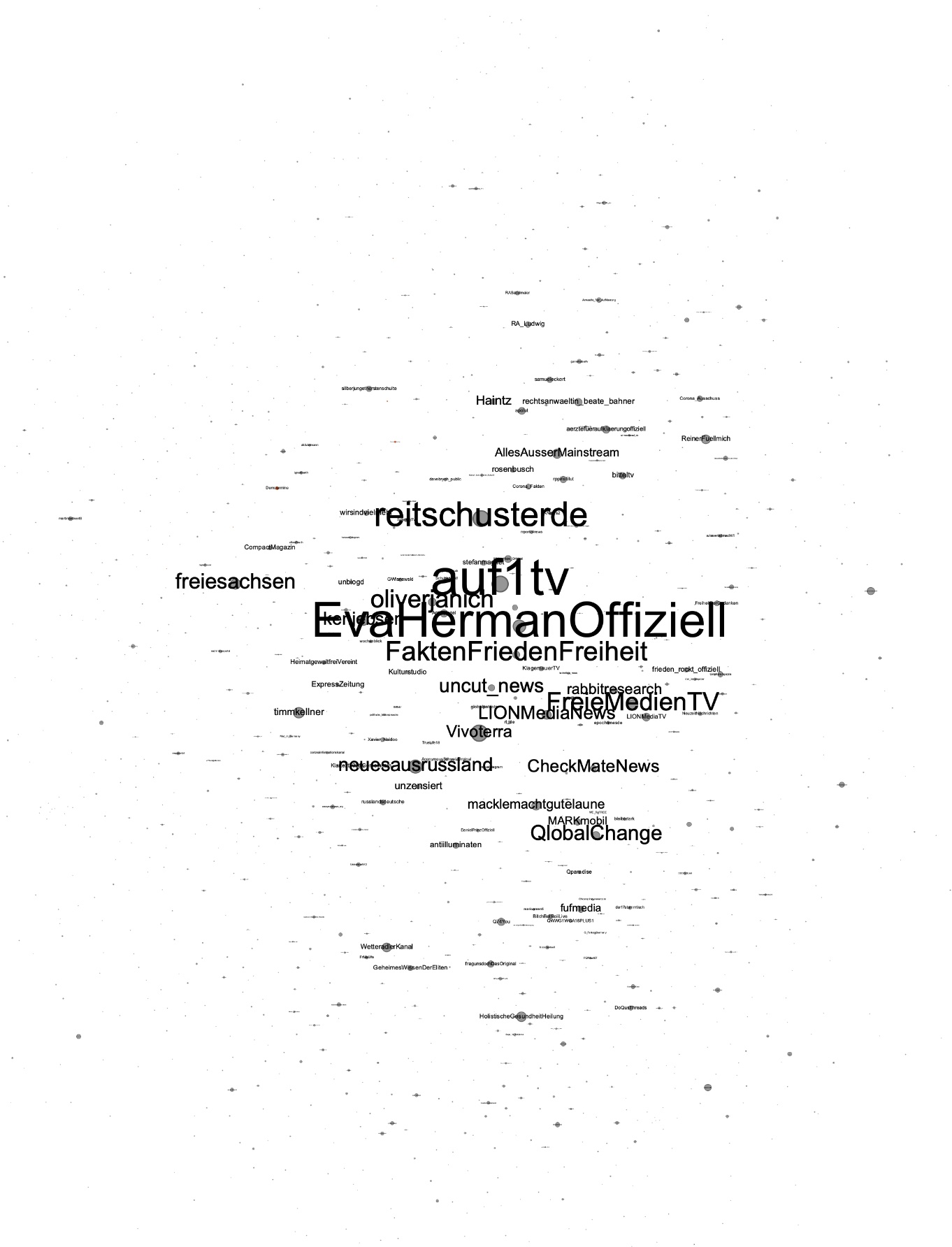
When looking at the channels that most frequently spread news about Alexander Roth, it can be noted that these are particularly closely associated with actors and organizations from the far-right spectrum: for example, the COMPACT-Magazine, classified by the Federal Office for the Protection of the Constitution as “confirmed far-right” and under observation, is in direct proximity to “Antifa & Enlightenment by Remstal Rebels” and “With Bribes, Scandals, Corruption to the NWO: It can’t be what it isn’t! – Uncoverers, Revealers, Whistleblowers” as well as “Demo Dates.” Likewise, the “Freie Sachsen,” classified by the Federal Office for the Protection of the Constitution as a case under suspicion, is in immediate proximity to these channels – this suggests a strong overlap in content, and at least the channels target a very similar audience as COMPACT and Freie Sachsen. Other well-known actors from the milieu, especially from the Identitarian Movement, such as “Aktivist Mann” (Matthäus Westfal), Ignaz Bearth, and Martin Sellner, can also be found.
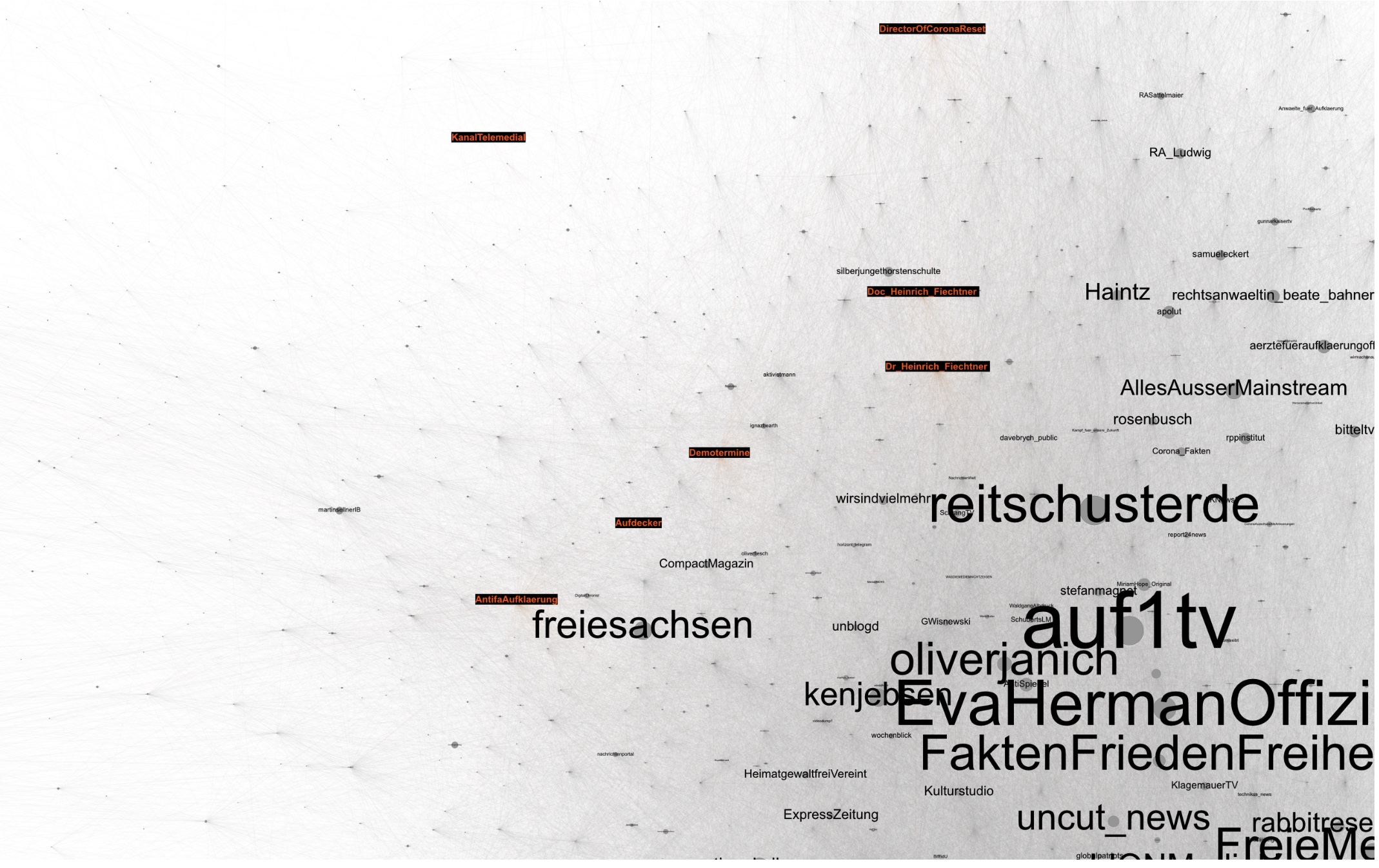
Graphic: The channels that had published news about Alexander Roth are highlighted.
Heinrich Fiechtner’s two channels serve as a bridge to channels primarily associated with the Querdenken movement, such as lawyer Markus Haintz and physician Bodo Schiffmann. In direct geographic proximity to these two channels is Thorsten Schulte, a YouTuber and author who goes by the name “Silberjunge.” He is known for his conspiracy ideology books and videos and is a regular guest on numerous other conspiracy ideology formats. During the Querdenken protests, he also frequently appeared on the movement’s stages.
Somewhat further away from the other actors are “Kanal Telemedial” and the “Director of Corona Reset” – both channel operators are active in Baden-Württemberg and are also part of the conspiracy ideology milieu. However, they are less frequently cited by the rest of the network and are primarily located at the network’s periphery.
Conclusion
Alexander Roth has been repeatedly attacked by a conspiracy ideology and far-right milieu in his work. These attacks were not only defamatory but also aimed at intimidation with the goal of suppressing critical reporting on ongoing protests by Roth. This can be inferred not only from the content of the messages but also from the fact that the channels spreading these messages have strong connections, especially to the far-right scene, or serve as a bridge between this scene and the so-called Querdenken movement.
The attacks were not limited to the COVID-19 pandemic: messages targeting Alexander Roth continue to appear, and the frequency of these messages has been consistently high over the years. As all actors are also in close geographical proximity to Roth, the threat potential for the journalist on-site increases. Local journalism becomes a more concrete target than the more abstract “capital city journalism” – the journalist’s workspaces are known, and possibly also their place of residence and hobbies.
With the increasing number of messages, the likelihood of physical attacks must also be considered – the enemy image created and personified by channel operators and group members can and will be harassed and threatened on-site.
The project Decoding the disinformation playbook of populism in Europe is supported by the European Media and Information Fund, managed by the Calouste Gulbenkian Foundation.
Disclaimer:
The sole responsibility for any content supported by the European Media and Information Fund lies with the author(s) and it may not necessarily reflect the positions of the EMIF and the Fund Partners, the Calouste Gulbenkian Foundation and the European University Institute.


